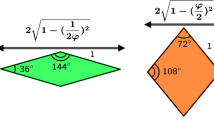Abstract
In this work we demonstrate the robustness of a real-space approach for the treatment of infinite systems described with periodic boundary conditions that we have recently proposed (Tavernier et al in J Phys Chem Lett 17:7090, 2000). In our approach we extract a fragment, i.e., a supercell, out of the infinite system, and then modifying its topology into the that of a Clifford torus which is a flat, finite and border-less manifold. We then renormalize the distance between two points by defining it as the Euclidean distance in the embedding space of the Clifford torus. With our method we have been able to calculate the reference results available in the literature with a remarkable accuracy, and at a very low computational effort. In this work we show that our approach is robust with respect to the shape of the supercell. In particular, we show that the Madelung constants converge to the same values but that the convergence properties are different. Our approach scales linearly with the number of atoms. The calculation of Madelung constants only takes a few seconds on a laptop computer for a relative precision of about 10\(^{-6}\).








Similar content being viewed by others
References
Rudin W (1964) Principles of mathematical analysis. McGraw-Hill, New York
Evjen HM (1932) Phys Rev 39(4):675
Ewald PP (1921) Ann Phys 369(3):253
Darden T, York D, Pedersen L (1993) J Chem Phys 98(12):10089
Essmann U, Perera L, Berkowitz ML, Darden T, Lee H, Pedersen LG (1995) J Chem Phys 103(19):8577
Eastwood J, Hockney R, Lawrence D (1980) Comput Phys Commun 19:215
Pippig M, Potts D (2013) SIAM J Sci Comput 35(4):C411
Lindbo D, Tornberg AK (2012) J Chem Phys 136(16):164111
Rokhlin V (1985) J Comp Phys 60(2):187
Tavernier N, Bendazzoli GL, Brumas V, Evangelisti S, Berger JA (2020) J Phys Chem Lett 11(17):7090
Valença Ferreira de Aragão E, Moreno D, Battaglia S, Bendazzoli GL, Evangelisti S, Leininger T, Suaud N, Berger JA (2019) Phys Rev B 99(20):205144
Bredow T, Geudtner G, Jug K (2001) J Comput Chem 22(1):89
Mamode M (2014) Bound Value Probl 2014(1):221
Mamode M (2017) J Math Chem 55(3):734
Madelung E (1918) Phys Z 19:524–532
Coogan C (1967) Aust J Chem 20(12):2551
Gellé A, Lepetit MB (2008) J Chem Phys 128(24):244716
Hojendahl K (1938) Mat Phys Medd dan Vid selsk 16(2):138
Sousa C, Casanovas J, Rubio J, Illas F (1993) J Comput Chem 14(6):680. https://doi.org/10.1002/jcc.540140608
Derenzo SE, Klintenberg MK, Weber MJ (2000) J Chem Phys 112(5):2074
Nijboer B, De Wette F (1957) Physica 23(1):309
Glasser M, Zucker I (1980) Lattice sums. Elsevier, pp 67–139
Borwein JM, Glasser ML, McPhedran RC, Wan JG, Zucker IJ (2013) Lattice sums then and now. Cambridge University Press, Cambridge
Borwein D, Borwein JM, Taylor KF (1985) J Math Phys 26(11):2999
Borwein D, Borwein JM, Pinner C (1998) Trans Am Math Soc 350(8):3131
Volkert K (2013) Bulletin of the Manifold Atlas, pp 1–5
McIntosh A, Mitrea M (1999) Math Methods Appl Sci 22(18):1599
Clifford (1871) Proc Lond Math Soc s1-4(1):381
Klein F (1890) Math Ann 37(4):544
Bianchi L (1896) Ann Mate 24(1):93
Hudelson M (2010) Math Mag 83(4):294
http://oeis.org/A085469. The Online Encyclopedia of Integer Sequences
Diaz-Marquez A, Battaglia S, Bendazzoli GL, Evangelisti S, Leininger T, Berger JA (2018) J Chem Phys 148(12):124103
Escobar Azor M, Brooke L, Evangelisti S, Leininger T, Loos PF, Suaud N, Berger JA (2019) Sci Post Phys Core 1(1):001
Wigner E (1934) Phys Rev 46:1002
Alves E, Bendazzoli GL, Evangelist S, Berger JA (2021) Phys Rev B 103:245125
Acknowledgements
We wish to dedicate this article to our friend and colleague Fernand Spiegelman, of the Laboratoire de Chimie et Physique Quantiques in Toulouse, on occasion of his retirement. We would like to thank Prof. Richard E. Schwartz (Brown University) for helpful discussions. This work was partly supported by the French “Centre National de la Recherche Scientifique” (CNRS, also under the PICS Action 4263). It has received funding from the European Union’s Horizon 2020 research and innovation program under the Marie Skłodowska-Curie Grant Agreement No. 642294. This work was also supported by the “Programme Investissements d’Avenir” under the Program ANR-11-IDEX-0002-02, Reference ANR-10-LABX-0037-NEXT. The calculations of this work have been partly performed by using the resources of the HPC center CALMIP under the Grant 2016-p1048.
Author information
Authors and Affiliations
Corresponding author
Additional information
Publisher's Note
Springer Nature remains neutral with regard to jurisdictional claims in published maps and institutional affiliations.
Published as part of the special collection of articles “Festschrift in honor of Fernand Spiegelmann”.
Rights and permissions
About this article
Cite this article
Tavernier, N., Bendazzoli, G.L., Brumas, V. et al. Clifford boundary conditions for periodic systems: the Madelung constant of cubic crystals in 1, 2 and 3 dimensions. Theor Chem Acc 140, 106 (2021). https://doi.org/10.1007/s00214-021-02805-1
Received:
Accepted:
Published:
DOI: https://doi.org/10.1007/s00214-021-02805-1



